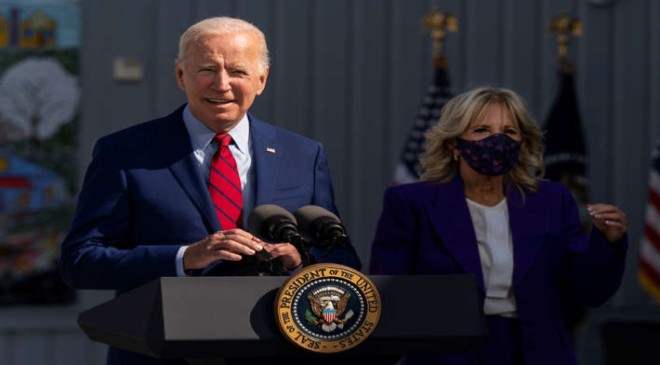WASHINGTON – The federal government is sending medical teams to six states – New York, New Jersey, Ohio, Rhode Island, Michigan and New Mexico – to help hospitals overburdened by COVID-19, USA TODAY has learned.
President Joe Biden is expected to announce the deployments Thursday when discussing steps the administration is taking to address a surge in infections driven by the omicron variant, according to a White House official.
His remarks come as hospitalizations for COVID-19 are setting records. Some hospitals are delaying elective surgeries as states are deploying National Guard members to health care facilities.
Facing pressure from even members of his own party to do more to get the pandemic under control, Biden’s new actions are expected to center on additional manpower
The need in hospitals is steep. And growing.
Roughly one in five hospitals reported having “critical staff shortages” in data released Wednesday by the Department of Health and Human Services, a USA TODAY analysis found. One in four anticipated critical shortages within the next week.
More than a third of hospitals in Vermont, Wyoming, Arizona, California and West Virginia already are experiencing critical staff shortages. In New Mexico and Rhode Island, it’s at least half, the data released Wednesday show.
Thursday will be the second time Biden has updated his winter pandemic strategy since announcing his plan at the beginning of December, just as omicron was starting its spread.
The additional steps Biden announced just before Christmas included mobilizing 1,000 more military doctors, nurses, paramedics, and other medical personnel to deploy to hospitals in January and February.
The surge teams Biden will announce Thursday are the first wave of those deployments. The teams are heading to:
- Cleveland Clinic in Ohio;
- Coney Island Hospital in Brooklyn;
- Rhode Island Hospital in Providence;
- Henry Ford Hospital just outside Detroit;
- University of New Mexico hospital in Albuquerque;
- University Hospital in Newark, New Jersey.
Some of the hospitals are getting seven to ten health care workers. Others are receiving between 20 and 25.
The teams, and those to be deployed in the coming weeks, are expected to help emergency departments overwhelmed by COVID -19 and to free up health care workers to continue other lifesaving care.
Biden, along with the heads of the Defense Department and Federal Emergency Management Agency, will speak Thursday with federal surge teams already supporting hospitals in Arizona, New York and Michigan about the impact they’ve had and what they’ve learned.
Since surge response teams were first created in July to respond to the delta variant, more than 3,000 personnel have been deployed on a rotating basis to 39 states and four U.S. territories, according to the administration.
Michael Osterholm, director of the Center for Infectious Disease Research and Policy at the University of Minnesota, said the additional 1,000 troops Biden is now dispatching are only a drop in the bucket of what’s needed.
Osterholm, who advised Biden during the transition, estimated more than 10% of the country’s 9.8 million doctors, nurses and specialized medical technicians will be infected by COVID-19.
Those 980,000 people who will not be able to work cannot be replaced with just 1,000 military health care personnel, he told USA TODAY.
“When people heard that there were going to be 1,000 (military) individuals shifted to private sector hospital support, that seems like a lot,” he said. “I mean, it is, but at the same time, when you look at the number that could be out, that’s also a very, very large number.”
The heads of more than 100 overworked North Carolina hospitals pleaded with the public on Wednesday to help slow the spread of COVID-19 by getting vaccinated, wearing a mask and taking other preventive measures.
With hospitalizations shattering records, health care workers are struggling to care for those with other urgent medical needs that are not COVID-related, the hospital officials said in a public letter to “patients, families and communities we are proud to serve.”
“It is heartbreaking,” they wrote, “which is why we are reaching out to you.”
Dr. Abraar Karan, an infectious disease fellow at Stanford University, took to Twitter last week to share stats showing the number of health care workers testing positive at the hospital there tripled in a week.
The ability of a hospital to hang on can change in a day, he said.
The federal medical personnel the administration is dispatching not only can’t be everywhere, Karan said, but they also need time to orient when they land.
“They have to learn how to work within the hospital infrastructure,” he said. “It’s not ideal.”
Asked by reporters Tuesday if the administration is doing enough, Biden said he’s been able to “generate significant federal help, in terms of folks both coming into the hospitals and administering all the help that these states need.”
“I’m confident we’re on the right track,” he said.
But, for the first time, more Americans disapprove of Biden’s handling of COVID-19 than approve, according to polling averages from FiveThirtyEight.
More than four dozen congressional Democrats signed a letter to Biden this week urging additional actions to improve COVID-19 testing.
Sen. Patty Murray, D-Wash., opened a Senate hearing Tuesday sharing her constituents’ frustrations with long testing lines, concerns about whether schools will remain open, and how hospitals and health care providers are stretched thin.
“What can my constituents expect to see improved this week and the week after?” Murray asked top administration officials working on the pandemic response.
The pressure on health care workers will continue for at least a couple of weeks, said Dr. Wafaa El-Sadr, an infectious diseases expert and director of ICAP, a global health center at Columbia University.
If omicron’s spread in the United States mimics what’s happened in other countries, a drop in cases could happen as quickly as they increased.
The data from New York City, one of the nation’s first omicron hotspots, show signs that cases may have already peaked, El-Sadr said.
“But the next week or two will be critical to see the direction,” she added. “If we start seeing that we’ve peaked, and we’re coming down the other side of the mountain, then that will certainly be reassuring in terms of pressure letting up at the hospitals.”





















